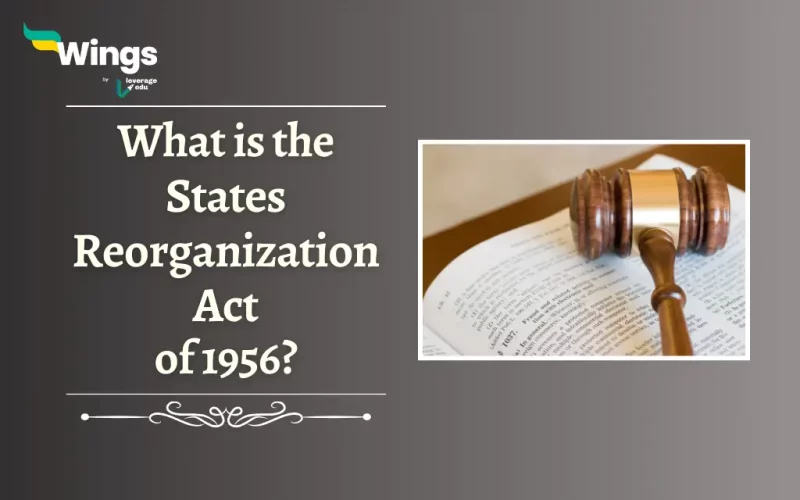After independence, India inherited a complex mess of States from the British rule and the princely states. Furthermore, for the reorganization of the States and the country, a Committee in 1953 recommended redrawing State borders based on language and culture. Therefore, this led to the States Reorganization Act of 1956, which reshaped India’s map into more unified States. Read on to learn more about the States Reorganization Act, the Important Provisions of the Act, the Classification of the States as well as the important Events from 1948 to 2000.
State Reorganization Commission
The States Reorganization Commission was formed in 1953 under Fazal Ali.
- Moreover, the Commission replaced an earlier commission that focused on language.
- This new Commission considered language, culture, and administrative needs.
- Additionally, their 1955 report led to the States Reorganization Act of 1956, hence redrawing India’s map to create more unified States.
Also Read: What is State Autonomy in India?
Important Provisions of the States Reorganization Act of 1956
Furthermore, here are the important Provisions of the States Reorganization Act of 1956:
- Merged states: Telugu-speaking regions joined to form Andhra Pradesh.
- Kannada-speaking areas came together to form a bigger Mysore state.
- Reshaped states: Bombay gained Marathi-speaking areas but lost some southern districts to Mysore.
- Moreover, Madhya Pradesh absorbed several smaller states.
- Punjab was enlarged.
- Created new states: Kerala was formed by merging regions with Malayalam as the main language.
- Union Territories: Some smaller States and territories became Union Territories and are directly governed by the central government.
Also Read: Who is a Governor of a State in India?
Classification of States of India
The Indian Constitution of 1950 divided the States into four categories which are Part A, B, C, and D States.
| Classification of States of India | ||
| Type | Description | Examples |
| Part A | Former governors’ provinces of British India | Bihar, Assam, Bombay, Madras, Madhya Pradesh, Orissa, Punjab, West Bengal, Uttar Pradesh |
| Part B | Former princely states or unions of princely states | Rajasthan, Saurashtra, Mysore, Patiala, East Punjab States Union, Hyderabad, Jammu and Kashmir, Madhya Bharat, Travancore-Cochin |
| Part C | Some princely states and former chief commissioners’ provinces | Bhopal, Ajmer, Tripura, Vindhya Pradesh, Himachal Pradesh, Delhi, Bilaspur, Coorg, Cutch, Manipur |
| Part D | Andaman and Nicobar Islands | Andaman and Nicobar Islands |
Also Read: What is National Integration in India?
States and UT Formed by the States Reorganization Act of 1956
In addition, here is a table listing the changes and formations of States in 1956:
| Changes and Formations of States by the States Reorganization Act of 1956 | |
| State | Feature |
| Andhra Pradesh | Formed by merging Telugu-speaking regions of Hyderabad with Andhra state. |
| Assam | Subsequently divided into Arunachal Pradesh, Mizoram, Nagaland, and Meghalaya. |
| Bihar | Reduced by transferring small territories to West Bengal. |
| Bombay State | Expanded by adding Marathi-speaking region of Berar Division, Nagpur Division, Saurashtra state, Kutch state, and Marathwada region of Hyderabad state. |
| Jammu and Kashmir | Expanded by adding the Marathi-speaking region of Berar Division, Nagpur Division, Saurashtra state, Kutch state, and Marathwada region of Hyderabad state. |
| Kerala | Formed by merging Travancore-Cochin state with Malabar district and Kasaragod taluk of South Canara district. |
| Madhya Pradesh | Expanded by merging Madhya Bharat, Vindhya Pradesh, and Bhopal State. |
| Madras State | Expanded by adding Sengottai Taluk, Kanyakumari district, and southern parts of Travancore Cochin. |
| Mysore State | Enlarged by adding Coorg state and Kannada-speaking regions from Madras Presidency, Bombay Presidency, and Hyderabad state. |
| Orissa | No boundary changes were observed in 1956. |
| Punjab | Expanded by adding Patiala and East Punjab States Union. |
| Rajasthan | Added Ajmer state, parts of Bombay, and Madhya Pradesh States. |
| Uttar Pradesh | No changes in boundaries. |
| West Bengal | Added Purulia district from Bihar. |
Notably, 5 leftover territories from the State Reorganization became India’s Union Territories:
- Delhi
- Manipur
- Andaman & Nicobar
- Tripura
- Himachal Pradesh
Also Read: What is the Difference Between States and Union Territories of India?
Important Events
The 1950 Constitution classified States into four types. To create Permanent States, the Dhar Commission in 1948 focused on language but also considered history, economy, and geography. Interestingly, the Commission favoured administrative needs over pure language in redrawing State boundaries.
Related Blogs
Lastly, we hope you liked our blog and gained an understanding of the States Reorganization Act. Moreover, you may even read more blogs and empower yourself with knowledge regarding Civics and Polity!
 One app for all your study abroad needs
One app for all your study abroad needs













